
The Boletaceae are a family of mushroom-forming fungi, primarily characterised by small pores on the spore-bearing hymenial surface, instead of gills as are found in most agarics. Nearly as widely distributed as the agarics, the family is renowned for hosting some prime edible species highly sought after by mushroom hunters worldwide, such as the cep or king bolete . A number of rare or threatened species are also present in the family, that have become the focus of increasing conservation concerns. As a whole, the typical members of the family are commonly known as boletes.

Caloboletus calopus, commonly known as the bitter bolete, bitter beech bolete or scarlet-stemmed bolete, is a fungus of the bolete family, found in Asia, Northern Europe and North America. Appearing in coniferous and deciduous woodland in summer and autumn, the stout fruit bodies are attractively coloured, with a beige to olive cap up to 15 cm (6 in) across, yellow pores, and a reddish stipe up to 15 cm (6 in) long and 5 cm (2 in) wide. The pale yellow flesh stains blue when broken or bruised.

Tylopilus felleus, commonly known as the bitter bolete or the bitter tylopilus, is a fungus of the bolete family. Its distribution includes east Asia, Europe and eastern North America, extending south into Mexico and Central America. A mycorrhizal species, it grows in deciduous and coniferous woodland, often fruiting under beech and oak. Its fruit bodies have convex to flat caps that are some shade of brown, buff or tan and typically measure up to 15 cm (6 in) in diameter. The pore surface is initially white before turning pinkish with age. Like most boletes it lacks a ring and it may be distinguished from Boletus edulis and other similar species by its unusual pink pores and the prominent dark-brown net-like pattern on its stalk.

Neoboletus luridiformis, also previously known as Boletus luridiformis and (invalidly) as Boletus erythropus, is a fungus of the bolete family, all of which produce mushrooms with tubes and pores beneath their caps. It is found in Northern Europe and North America, and is commonly known as the scarletina bolete, for its red pores, which are yellow when young. Other common names include the red foot bolete, dotted stemmed bolete, or dotted stem bolete.

Rubroboletus pulcherrimus, known as Boletus pulcherrimus until 2015, and commonly known as the red-pored bolete, is a species of mushroom in the family Boletaceae. It is a large bolete from Western North America with distinguishing features that include a netted surface on the stem, a red to brown cap and stem color, and red pores that stain blue upon injury. Until 2005 this was the only bolete that has been implicated in the death of someone consuming it; a couple developed gastrointestinal symptoms in 1994 after eating this fungus with the husband succumbing. Autopsy revealed infarction of the midgut.

Suillellus luridus, commonly known as the lurid bolete, is a fungus of the family Boletaceae, found in calcareous broadleaved woodlands in Europe. Fruit bodies appear in summer and autumn and may be locally abundant. It is a firm bolete with an olive-brown cap up to 20 cm (8 in) in diameter, with small orange or red pores on the underside. The stout ochre stem reaches 8–14 cm (3–6 in) high and 1–3 cm (0.4–1.2 in) wide, and is patterned with a red network. Like several other red-pored boletes, it stains blue when bruised or cut.
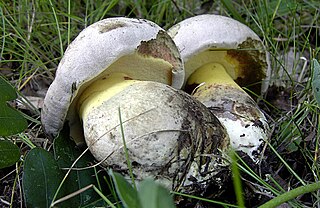
Caloboletus radicans, also known as the rooting bolete or whitish bolete, is a large ectomycorrhizal fungus found in Europe under broad-leaved trees, fruiting during the summer and autumn months. It has a pale buff or greyish-white cap, yellow pores and a stout stipe, and stains intensely blue when handled or cut. Bitter and inedible, it can cause severe vomiting and diarrhoea if eaten. Until 2014 it was placed in genus Boletus, but has since been transferred to the new genus Caloboletus based on molecular phylogenetic data.
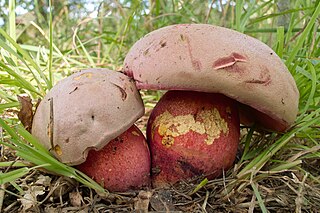
Rubroboletus legaliae, previously known as Boletus splendidus, B. satanoides, and B. legaliae is a basidiomycete fungus of the family Boletaceae. It is poisonous, with predominantly gastrointestinal symptoms, and is related to Rubroboletus satanas.

Exsudoporus frostii, commonly known as Frost's bolete or the apple bolete, is a bolete fungus first described scientifically in 1874. A member of the family Boletaceae, the mushrooms produced by the fungus have tubes and pores instead of gills on the underside of their caps. Exsudoporus frostii is distributed in the eastern United States from Maine to Georgia, and in the southwest from Arizona extending south to Mexico and Costa Rica. A mycorrhizal species, its fruit bodies are typically found growing near hardwood trees, especially oak.
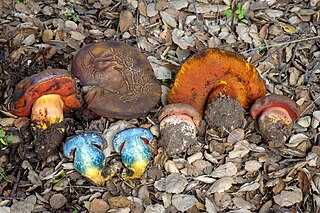
Suillellus amygdalinus is a fungus of the bolete family found in western North America. The fruit bodies, or mushrooms, are characterized by their thick, red to brown caps, red pores, and the strong bluing reaction observed when the mushroom tissue is injured or cut. The cap can reach diameters of up to 12 cm (4.7 in) and the stipe 9 cm (3.5 in) long by 3 cm (1.2 in) thick at maturity. This mushroom has been found in manzanita and madrone woodlands of central California north to southern Oregon. Although the edibility of the mushroom is not known with certainty, it may be poisonous, and is not recommended for consumption. Other similar red-pored, bluing boletes from North America, including Rubroboletus eastwoodiae, Boletus luridiformis, and B. subvelutipes, can be distinguished from S. amygdalinus either by the color of the cap, the degree of reticulation on the stipe, or by location.

Caloboletus rubripes, commonly known as the red-stipe bolete or the red-stemmed bitter bolete, is a mushroom in the family Boletaceae. It was known as Boletus rubripes until 2014. Fruit bodies (mushrooms) are robust, with caps up to 18 cm in diameter, atop thick stipes 5–12 cm long. Mushrooms are non-toxic, but is so bitter as to be inedible. The mushroom flesh has a very strong bluing reaction when cut or damaged. and forms mycorrhizal relationships, primarily with conifers. It can be differentiated from similar boletes by its cap color and non-reticulate stipe.

Rubroboletus rhodoxanthus is a species of bolete in the family Boletaceae, native to Europe. Previously known as Boletus rhodoxanthus, it was transferred in 2014 to the newly erected genus Rubroboletus, based on DNA data.

Tylopilus tabacinus is a species of bolete fungus in the family Boletaceae. It is characterized by a tawny-brown cap measuring up to 17.5 cm (6.9 in) in diameter, and a reticulated stem up to 16.5 cm (6.5 in) long by 6 cm (2.4 in) thick. A characteristic microscopic feature is the distinctive crystalline substance encrusted on the hyphae in the surface of the cap. The species is known from the eastern United States from Florida north to Rhode Island, and west to Mississippi, and from eastern Mexico. It is a mycorrhizal species, and associates with oak and beech trees.
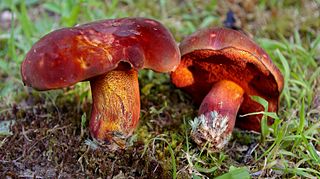
Boletus rubroflammeus is a species of bolete fungus in the family Boletaceae. First described from Michigan in 1971, it is found in the eastern United States and Mexico, where it grows in a mycorrhizal association with hardwood trees. The fruit bodies (mushrooms) of the fungus have caps that are deep red to purplish red, and dark red pores. The stem has coarse, dark red reticulations and a narrow yellow area at the top. All parts of the mushroom quickly stain blue when injured or cut. Lookalikes include Boletus flammans, a lighter-colored species that grows with conifers. Other similar species can be distinguished by differences in distribution, morphology, staining reaction, and microscopic characteristics. Boletus rubroflammeus mushrooms are poisonous, and can cause gastrointestinal distress if consumed.
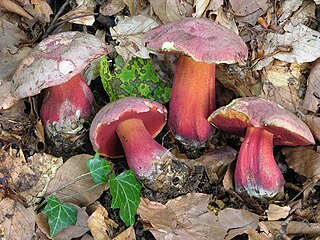
Rubroboletus rubrosanguineus is a species of bolete fungus in the family Boletaceae that is found in Europe.

Harrya chromapes, commonly known as the yellowfoot bolete or the chrome-footed bolete, is a species of bolete fungus in the family Boletaceae. The bolete is found in eastern North America, Costa Rica, and eastern Asia, where it grows on the ground, in a mycorrhizal association with deciduous and coniferous trees. Fruit bodies have smooth, rose-pink caps that are initially convex before flattening out. The pores on the cap undersurface are white, aging to a pale pink as the spores mature. The thick stipe has fine pink or reddish dots (scabers), and is white to pinkish but with a bright yellow base. The mushrooms are edible but are popular with insects, and so they are often infested with maggots.

Boletus subluridellus is a species of bolete fungus in the family Boletaceae. Described as new to science in 1971 by American mycologists, the bolete is found in the eastern United States and Canada. It grows on the ground in coniferous and mixed forests in a mycorrhizal association with deciduous trees, especially oak. The fruit bodies (mushrooms) have orangish-red, broadly convex caps that are up to 10 cm (3.9 in) in diameter, with small, dark reddish pores on the underside. The pale yellow stipe measures 4–9 cm (1.6–3.5 in) long by 1.5–2.3 cm (0.6–0.9 in) thick. All parts of the fruit body will quickly stain blue when injured or touched.

Rubroboletus is a genus of bolete fungi in the family Boletaceae. It was circumscribed by Chinese mycologists in 2014 with Rubroboletus sinicus as the type species. Species are characterized by having a reddish cap surface, yellow tubes on the underside of the cap, and an orange-red to blood-red pore surface. Pinkish to red spots (reticula) are present on the stipe surface, and a bluish color change occurs when the bolete flesh is injured. Rubroboletus mushrooms have an olive-brown spore print, and produce smooth spores. Eight species were included in the original circumscription ; five were added in 2015, and another in 2017.

Sutorius eximius, commonly known as the lilac-brown bolete, is a species of fungus in the family Boletaceae. This bolete produces fruit bodies that are dark purple to chocolate brown in color with a smooth cap, a finely scaly stipe, and a reddish-brown spore print. The tiny pores on the cap underside are chocolate to violet brown. It is widely distributed, having been recorded on North America, South America, and Asia, where it grows in a mycorrhizal relationship with both coniferous and deciduous trees.

Imleria badia, commonly known as the bay bolete, is an edible, pored mushroom found in Eurasia and North America, where it grows in coniferous or mixed woods on the ground or on decaying tree stumps, sometimes in prolific numbers. Both the common and scientific names refer to the bay- or chestnut-coloured cap, which is almost spherical in young specimens before broadening and flattening out to a diameter up to 15 cm (6 in). On the cap underside are small yellowish pores that turn dull blue-grey when bruised. The smooth, cylindrical stipe, measuring 4–9 cm long by 1–2 cm thick, is coloured like the cap, but paler. Some varieties have been described from eastern North America, differing from the main type in both macroscopic and microscopic morphology.






















